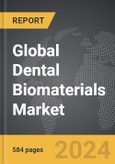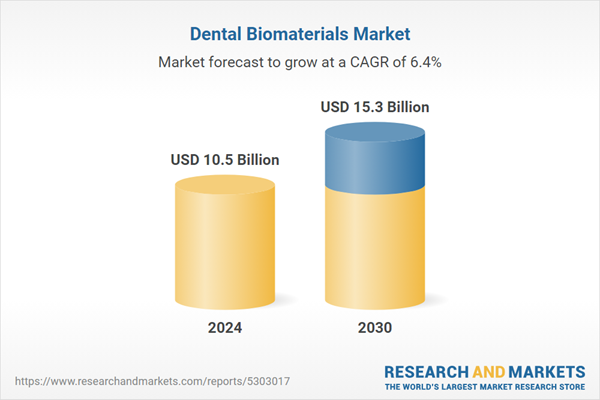The global market for Dental Biomaterials was valued at US$10.5 Billion in 2024 and is projected to reach US$15.3 Billion by 2030, growing at a CAGR of 6.4% from 2024 to 2030. This comprehensive report provides an in-depth analysis of market trends, drivers, and forecasts, helping you make informed business decisions. The report includes the most recent global tariff developments and how they impact the Dental Biomaterials market.
The development of dental biomaterials has been driven by advancements in material science and a deeper understanding of the biological interactions between these materials and the human body. Modern dental biomaterials are engineered to mimic the physical and mechanical properties of natural dental tissues, ensuring functionality and longevity. For instance, bioactive glass and calcium phosphate-based materials are used in bone grafts to promote bone regeneration and healing. Additionally, the incorporation of nanotechnology in dental materials has led to the creation of nanocomposites and nanoparticle-infused resins that exhibit superior properties, such as increased strength, wear resistance, and antibacterial effects. These innovations not only improve the success rates of dental procedures but also enhance patient comfort and satisfaction by reducing treatment times and improving aesthetic outcomes.
The growth in the dental biomaterials market is driven by several factors, including technological advancements, increasing prevalence of dental disorders, and rising demand for cosmetic dentistry. Technological progress has enabled the development of advanced materials that offer better performance and longer lifespan, which in turn has increased their adoption in clinical practice. The growing awareness of oral health and the rising incidence of dental issues such as cavities, periodontal diseases, and tooth loss have created a substantial demand for effective and durable dental restorations. Furthermore, the expanding middle-class population with higher disposable incomes has fueled the demand for cosmetic dental procedures, driving the need for aesthetically pleasing and minimally invasive biomaterials. Additionally, the aging global population, which is more susceptible to dental problems, further supports market growth. As a result, the dental biomaterials market is poised for significant expansion, driven by continuous innovations, increasing healthcare spending, and evolving patient preferences.
Segments: Type (Ceramic, Metallic, Polymeric, Metal-Ceramic, Natural, Composites); Application (Orthodontics, Implantology, Prosthodontics, Other Applications); End-Use (Dental Laboratories, Dental Hospitals & Clinics, Dental Academies & Research Institutes, Dental Product Manufacturers).
Geographic Regions/Countries: World; USA; Canada; Japan; China; Europe; France; Germany; Italy; UK; Spain; Russia; Rest of Europe; Asia-Pacific; Australia; India; South Korea; Rest of Asia-Pacific; Latin America; Argentina; Brazil; Mexico; Rest of Latin America; Middle East; Iran; Israel; Saudi Arabia; UAE; Rest of Middle East; Africa.
The analysts continuously track trade developments worldwide, drawing insights from leading global economists and over 200 industry and policy institutions, including think tanks, trade organizations, and national economic advisory bodies. This intelligence is integrated into forecasting models to provide timely, data-driven analysis of emerging risks and opportunities.
Global Dental Biomaterials Market - Key Trends & Drivers Summarized
Dental biomaterials are specialized materials designed for use in the field of dentistry to restore and replace damaged or missing dental tissues. These materials encompass a wide range of products, including dental implants, crowns, bridges, fillings, and bone grafts, each tailored to meet specific clinical requirements. Dental biomaterials are classified into several categories based on their composition and function: metals, ceramics, polymers, and composites. Metals such as titanium and its alloys are commonly used for dental implants due to their exceptional strength, biocompatibility, and ability to integrate with bone tissue. Ceramics, particularly zirconia and porcelain, are favored for their aesthetic properties and durability, making them ideal for crowns and veneers. Polymers and composites, often used in fillings and bonding agents, offer versatility and ease of application, enhancing both the functional and aesthetic outcomes of dental treatments.The development of dental biomaterials has been driven by advancements in material science and a deeper understanding of the biological interactions between these materials and the human body. Modern dental biomaterials are engineered to mimic the physical and mechanical properties of natural dental tissues, ensuring functionality and longevity. For instance, bioactive glass and calcium phosphate-based materials are used in bone grafts to promote bone regeneration and healing. Additionally, the incorporation of nanotechnology in dental materials has led to the creation of nanocomposites and nanoparticle-infused resins that exhibit superior properties, such as increased strength, wear resistance, and antibacterial effects. These innovations not only improve the success rates of dental procedures but also enhance patient comfort and satisfaction by reducing treatment times and improving aesthetic outcomes.
The growth in the dental biomaterials market is driven by several factors, including technological advancements, increasing prevalence of dental disorders, and rising demand for cosmetic dentistry. Technological progress has enabled the development of advanced materials that offer better performance and longer lifespan, which in turn has increased their adoption in clinical practice. The growing awareness of oral health and the rising incidence of dental issues such as cavities, periodontal diseases, and tooth loss have created a substantial demand for effective and durable dental restorations. Furthermore, the expanding middle-class population with higher disposable incomes has fueled the demand for cosmetic dental procedures, driving the need for aesthetically pleasing and minimally invasive biomaterials. Additionally, the aging global population, which is more susceptible to dental problems, further supports market growth. As a result, the dental biomaterials market is poised for significant expansion, driven by continuous innovations, increasing healthcare spending, and evolving patient preferences.
Report Scope
The report analyzes the Dental Biomaterials market, presented in terms of units. The analysis covers the key segments and geographic regions outlined below.Segments: Type (Ceramic, Metallic, Polymeric, Metal-Ceramic, Natural, Composites); Application (Orthodontics, Implantology, Prosthodontics, Other Applications); End-Use (Dental Laboratories, Dental Hospitals & Clinics, Dental Academies & Research Institutes, Dental Product Manufacturers).
Geographic Regions/Countries: World; USA; Canada; Japan; China; Europe; France; Germany; Italy; UK; Spain; Russia; Rest of Europe; Asia-Pacific; Australia; India; South Korea; Rest of Asia-Pacific; Latin America; Argentina; Brazil; Mexico; Rest of Latin America; Middle East; Iran; Israel; Saudi Arabia; UAE; Rest of Middle East; Africa.
Key Insights:
- Market Growth: Understand the significant growth trajectory of the Ceramic segment, which is expected to reach US$5.0 Billion by 2030 with a CAGR of a 5.4%. The Metallic segment is also set to grow at 6.3% CAGR over the analysis period.
- Regional Analysis: Gain insights into the U.S. market, valued at $3.0 Billion in 2024, and China, forecasted to grow at an impressive 9.7% CAGR to reach $1.9 Billion by 2030. Discover growth trends in other key regions, including Japan, Canada, Germany, and the Asia-Pacific.
Why You Should Buy This Report:
- Detailed Market Analysis: Access a thorough analysis of the Global Dental Biomaterials Market, covering all major geographic regions and market segments.
- Competitive Insights: Get an overview of the competitive landscape, including the market presence of major players across different geographies.
- Future Trends and Drivers: Understand the key trends and drivers shaping the future of the Global Dental Biomaterials Market.
- Actionable Insights: Benefit from actionable insights that can help you identify new revenue opportunities and make strategic business decisions.
Key Questions Answered:
- How is the Global Dental Biomaterials Market expected to evolve by 2030?
- What are the main drivers and restraints affecting the market?
- Which market segments will grow the most over the forecast period?
- How will market shares for different regions and segments change by 2030?
- Who are the leading players in the market, and what are their prospects?
Report Features:
- Comprehensive Market Data: Independent analysis of annual sales and market forecasts in US$ Million from 2024 to 2030.
- In-Depth Regional Analysis: Detailed insights into key markets, including the U.S., China, Japan, Canada, Europe, Asia-Pacific, Latin America, Middle East, and Africa.
- Company Profiles: Coverage of players such as 3M Company, Botiss Biomaterials GmbH, Carpenter Technology Corporation, Dentsply Sirona, Inc., GC Corporation and more.
- Complimentary Updates: Receive free report updates for one year to keep you informed of the latest market developments.
Some of the 105 companies featured in this Dental Biomaterials market report include:
- 3M Company
- Botiss Biomaterials GmbH
- Carpenter Technology Corporation
- Dentsply Sirona, Inc.
- GC Corporation
- Geistlich Pharma AG
- Henry Schein, Inc.
- Ivoclar Vivadent AG
- Keystone Dental Group
- Kuraray Co., Ltd.
- Medtronic PLC
- Mitsui Chemicals, Inc.
- Koninklijke DSM N.V.
- Institut Straumann AG
- Vannini Dental Industry SRL
- Victrex PLC
- ZimVie Inc.
Tariff Impact Analysis: Key Insights for 2025
Global tariff negotiations across 180+ countries are reshaping supply chains, costs, and competitiveness. This report reflects the latest developments as of April 2025 and incorporates forward-looking insights into the market outlook.The analysts continuously track trade developments worldwide, drawing insights from leading global economists and over 200 industry and policy institutions, including think tanks, trade organizations, and national economic advisory bodies. This intelligence is integrated into forecasting models to provide timely, data-driven analysis of emerging risks and opportunities.
What’s Included in This Edition:
- Tariff-adjusted market forecasts by region and segment
- Analysis of cost and supply chain implications by sourcing and trade exposure
- Strategic insights into geographic shifts
Buyers receive a free July 2025 update with:
- Finalized tariff impacts and new trade agreement effects
- Updated projections reflecting global sourcing and cost shifts
- Expanded country-specific coverage across the industry
Table of Contents
I. METHODOLOGYMII. EXECUTIVE SUMMARY2. FOCUS ON SELECT PLAYERSIII. MARKET ANALYSISCANADAITALYSPAINRUSSIAREST OF EUROPESOUTH KOREAREST OF ASIA-PACIFICARGENTINABRAZILMEXICOREST OF LATIN AMERICAIV. COMPETITION
1. MARKET OVERVIEW
3. MARKET TRENDS & DRIVERS
4. GLOBAL MARKET PERSPECTIVE
UNITED STATES
JAPAN
CHINA
EUROPE
FRANCE
GERMANY
UNITED KINGDOM
ASIA-PACIFIC
AUSTRALIA
INDIA
LATIN AMERICA
MIDDLE EAST
AFRICA
Companies Mentioned (Partial List)
A selection of companies mentioned in this report includes, but is not limited to:
- 3M Company
- Botiss Biomaterials GmbH
- Carpenter Technology Corporation
- Dentsply Sirona, Inc.
- GC Corporation
- Geistlich Pharma AG
- Henry Schein, Inc.
- Ivoclar Vivadent AG
- Keystone Dental Group
- Kuraray Co., Ltd.
- Medtronic PLC
- Mitsui Chemicals, Inc.
- Koninklijke DSM N.V.
- Institut Straumann AG
- Vannini Dental Industry SRL
- Victrex PLC
- ZimVie Inc.
Table Information
| Report Attribute | Details |
|---|---|
| No. of Pages | 584 |
| Published | April 2025 |
| Forecast Period | 2024 - 2030 |
| Estimated Market Value ( USD | $ 10.5 Billion |
| Forecasted Market Value ( USD | $ 15.3 Billion |
| Compound Annual Growth Rate | 6.4% |
| Regions Covered | Global |









